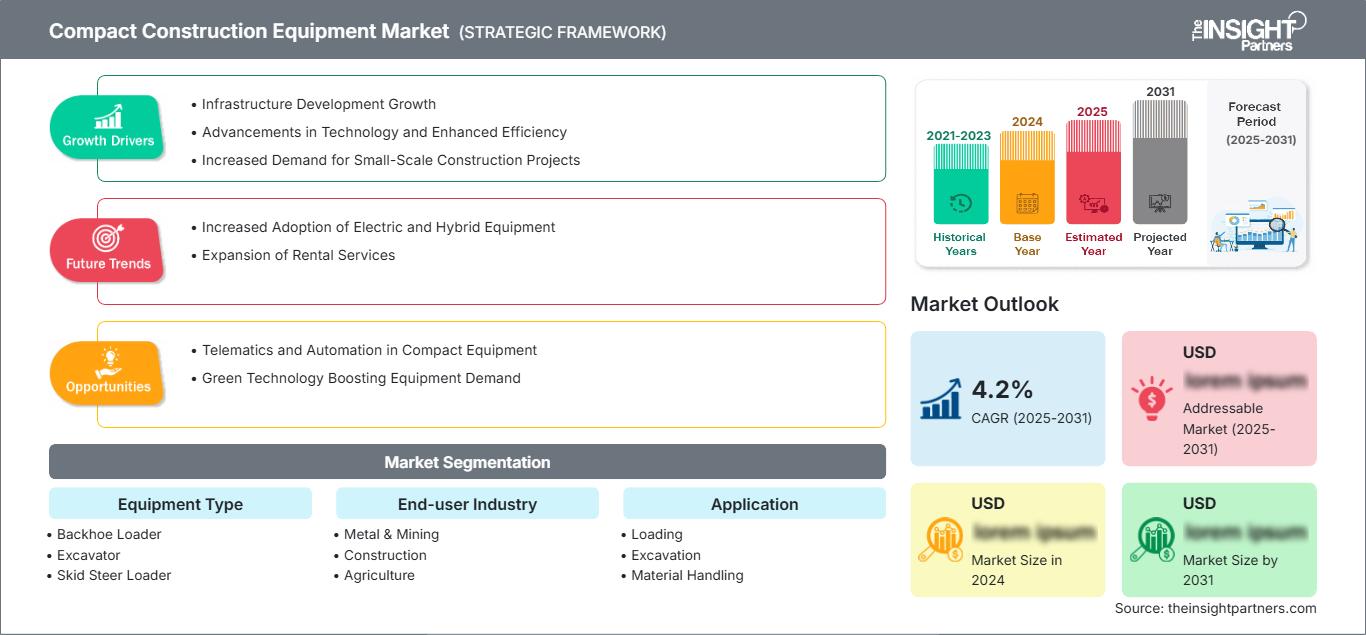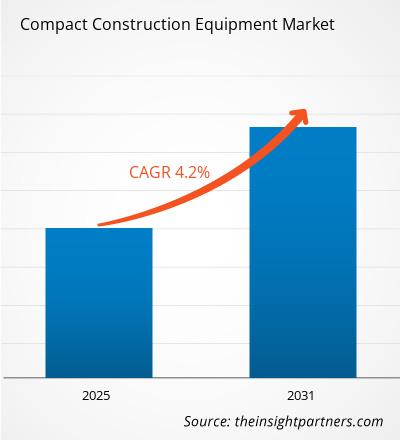Le marché des équipements de construction compacts devrait enregistrer un TCAC de 4,2 % entre 2025 et 2031, avec une taille de marché passant de XX millions de dollars américains en 2024 à XX millions de dollars américains d'ici 2031.
Le marché est segmenté en équipements, utilisateurs finaux et applications. Le segment des équipements est divisé en chargeuses-pelleteuses, excavatrices, chargeuses compactes, chariots télescopiques, chargeuses sur chenilles et autres. En fonction de l'utilisateur final, le marché est segmenté en métaux et mines, construction, agriculture et autres. En fonction de l'application, le marché est divisé en chargement, excavation, manutention, levage et hissage, et autres.
Objectif du rapport
Le rapport sur le marché des équipements de construction compacts de The Insight Partners vise à décrire le paysage actuel et la croissance future, les principaux facteurs moteurs, les défis et les opportunités. Cela fournira des informations à diverses parties prenantes commerciales, telles que :
- Fournisseurs/fabricants de technologie : pour comprendre l’évolution de la dynamique du marché et connaître les opportunités de croissance potentielles, leur permettant de prendre des décisions stratégiques éclairées.
- Investisseurs : pour effectuer une analyse complète des tendances concernant le taux de croissance du marché, les projections financières du marché et les opportunités qui existent tout au long de la chaîne de valeur.
- Organismes de réglementation : pour réglementer les politiques et surveiller les activités du marché dans le but de minimiser les abus, de préserver la confiance des investisseurs et de maintenir l’intégrité et la stabilité du marché.
Segmentation du marché des équipements de construction compacts Type d'équipement
- Chargeuse-rétrocaveuse
- Excavatrice
- Chargeuse compacte
- Chariot télescopique
- Chargeuse sur chenilles
- Autres
Secteur d'utilisation finale
- Métaux et mines
- Construction
- Agriculture
- Autres
Application
- Chargement
- Excavation
- Manutention de matériaux
- Levage et hissage
- Autres
Géographie
- Amérique du Nord
- Europe
- Asie-Pacifique
- Amérique du Sud et centrale
- Moyen-Orient et Afrique
Vous bénéficierez d’une personnalisation sur n’importe quel rapport - gratuitement - y compris des parties de ce rapport, ou une analyse au niveau du pays, un pack de données Excel, ainsi que de profiter d’offres exceptionnelles et de réductions pour les start-ups et les universités
Marché des équipements de construction compacts: Perspectives stratégiques

-
Obtenez les principales tendances clés du marché de ce rapport.Cet échantillon GRATUIT comprendra une analyse de données, allant des tendances du marché aux estimations et prévisions.
Moteurs de croissance du marché des équipements de construction compacts
- Croissance du développement des infrastructures : L’augmentation des investissements dans les projets d’infrastructures à l’échelle mondiale est devenue l’un des principaux moteurs du marché des équipements de construction compacts. Les gouvernements et le secteur privé investissent massivement dans la construction de routes, de ponts et de développements urbains, ce qui accroît la demande d’engins compacts capables de fonctionner en grand nombre dans des espaces restreints.
- Progrès technologiques et efficacité accrue : L’amélioration technologique des équipements de construction compacts, notamment l’efficacité énergétique, l’amélioration des performances et l’intégration télématique, alimente la croissance du marché. Ces innovations contribuent également à réduire les coûts d’exploitation en améliorant la productivité et en améliorant la gestion des équipements ; par conséquent, les engins de construction compacts restent très attractifs pour les entrepreneurs et les sociétés de location.
- Demande accrue pour les projets de construction à petite échelle : Ce type d’équipement est en demande croissante en raison de la recrudescence des projets de construction à petite échelle, comme les infrastructures résidentielles, d’aménagement paysager et les infrastructures des collectivités locales. Français Cela s'explique par le fait que les engins de chantier compacts sont très productifs, mais moins exigeants en termes d'espace de travail et de nombre d'ouvriers réduit. Ils peuvent effectuer diverses opérations telles que le creusement, le nivellement et le levage, entre autres.
Tendances futures du marché des engins de chantier compacts
- Adoption croissante des engins électriques et hybrides : L'introduction d'engins de chantier compacts électriques et hybrides est devenue très en vogue. En effet, ces machines permettent de réduire considérablement les émissions ainsi que les coûts d'exploitation pour les utilisateurs, sans compter les pressions réglementaires en faveur d'une écologie toujours plus forte dans le secteur de la construction.
- Expansion des services de location : La tendance à louer plutôt qu'à acheter des engins de chantier gagne du terrain. La plupart des entrepreneurs préfèrent louer des équipements de construction compacts pour éviter les dépenses d'investissement et réduire leur maintenance. D'où la nécessité d'un marché de location plus vaste pour répondre à cette demande.
Opportunités de marché pour les équipements de construction compacts
- Télématique et automatisation dans les équipements compacts : La télématique et l'automatisation, entre autres technologies de pointe, ouvrent de grandes perspectives aux équipements de construction compacts. La télématique peut contribuer de manière significative à améliorer l'efficacité opérationnelle, la sécurité et l'analyse des données en temps réel, rendant ces équipements compacts encore plus attractifs pour les entrepreneurs et les entreprises de construction.
- Les technologies vertes stimulent la demande d'équipements : Avec l'accent croissant mis sur le développement durable par le secteur de la construction, les équipements de construction compacts intégrant des technologies vertes sont voués à trouver davantage de débouchés. Les équipements à faibles émissions et économes en carburant peuvent attirer les clients soucieux de l'environnement et seront plus en phase avec les exigences réglementaires plus strictes.
Aperçu régional du marché des équipements de construction compacts
Les tendances régionales et les facteurs influençant le marché des engins de chantier compacts tout au long de la période de prévision ont été analysés en détail par les analystes de The Insight Partners. Cette section aborde également les segments et la géographie du marché des engins de chantier compacts en Amérique du Nord, en Europe, en Asie-Pacifique, au Moyen-Orient et en Afrique, ainsi qu'en Amérique du Sud et en Amérique centrale.
Portée du rapport sur le marché des équipements de construction compacts
| Attribut de rapport | Détails |
|---|---|
| Taille du marché en 2024 | US$ XX million |
| Taille du marché par 2031 | US$ XX Million |
| TCAC mondial (2025 - 2031) | 4.2% |
| Données historiques | 2021-2023 |
| Période de prévision | 2025-2031 |
| Segments couverts |
By Type d'équipement
|
| Régions et pays couverts |
Amérique du Nord
|
| Leaders du marché et profils d'entreprises clés |
|
Densité des acteurs du marché des équipements de construction compacts : comprendre son impact sur la dynamique des entreprises
Le marché des engins de chantier compacts connaît une croissance rapide, portée par une demande croissante des utilisateurs finaux, due à des facteurs tels que l'évolution des préférences des consommateurs, les avancées technologiques et une meilleure connaissance des avantages du produit. Face à cette demande croissante, les entreprises élargissent leur offre, innovent pour répondre aux besoins des consommateurs et capitalisent sur les nouvelles tendances, ce qui alimente la croissance du marché.

- Obtenez le Marché des équipements de construction compacts Aperçu des principaux acteurs clés
- Analyse historique (2 ans), année de base, prévision (7 ans) avec TCAC
- Analyse PEST et SWOT
- Taille du marché Valeur / Volume - Mondial, Régional, Pays
- Industrie et paysage concurrentiel
- Ensemble de données Excel
Rapports récents
Témoignages
Raison d'acheter
- Prise de décision éclairée
- Compréhension de la dynamique du marché
- Analyse concurrentielle
- Connaissances clients
- Prévisions de marché
- Atténuation des risques
- Planification stratégique
- Justification des investissements
- Identification des marchés émergents
- Amélioration des stratégies marketing
- Amélioration de l'efficacité opérationnelle
- Alignement sur les tendances réglementaires






















 Obtenez un échantillon gratuit pour - Marché des équipements de construction compacts
Obtenez un échantillon gratuit pour - Marché des équipements de construction compacts